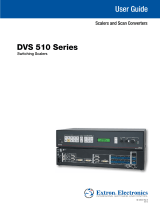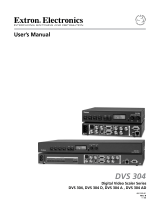
PIP 422 and PIP 444 • Setup Guide
2
PIP 422 and PIP 444 — Setup Guide (cont'd)
3
PIP 422 and PIP 444 • Setup Guide
Step 3 — Video outputs
Outputs — Connect a component video, S-video, or composite video display device (or all three) to these BNC connectors.
The figure below shows how to connect the various video formats.
Step 4 — Genlock connectors (PIP 444 only)
a. In(put) connector — Connect an external black burst signal to this BNC connector for genlocking the
video signal in broadcast or other sync-critical applications.
b. Out(put) connector — Connect any downstream equipment that requires genlocking to this BNC
connector to route the black burst signal throughout the system in broadcast or other sync-critical
applications.
N If no device is connected to the output, terminate the Genlock output with the included 75-ohm terminator.
Step 5 — Serial port
If desired, connect a control system or computer to the rear panel
RS-232/RS-422 port.
Step 6 — Power
AC power connector — Plug in a standard IEC power cord from a 100 to
240 VAC, 50 - 60 Hz power source into this receptacle.
Powering Up
Plug in the PIP, the input devices, and the
output device(s) into grounded AC power
sources and then turn on the input and
output devices. When AC power is
applied, the processor performs a self-test
that blinks all of the front panel LEDs and
then lights only the LEDs for the inputs
previously selected for the display. The
self-test also displays the model name, part
number, and the firmware version in the front panel LCD
display. After approximately 2 seconds, the LCD reverts to
its default display cycle, alternating among several displays;
one for each input that shows configuration of that input, and
the last showing the selected output standard. An error-free
power up self-test sequence leaves all of the LEDs, with the exception
of the LED(s) for the selected input off, and the LCD displaying the default display cycle.
Front Panel Controls and Operations
a
Freeze button and LEDs — Simultaneously press this button and an input button (
b
) to freeze the window for that input
in the displayed image.
The Freeze LED for the input lights. Repeat to unfreeze the window.
b
Input selector buttons — Press these buttons to enable or disable the inputs for display. The LEDs next to the buttons
light to indicate the inputs are enabled.
These buttons are also used with the Freeze button (
a
) to toggle the freeze function for a specific input on or off.
c
Swap button (PIP 422 only) — Press the Swap button to exchange all window sizing, positioning, and priority settings.
Press the Swap button again to return the windows to their previous settings.
d
Window preset buttons — Press these buttons to save or recall a preset. See “Save and recall a preset”, below, for more
information.
e
Window Select button and LEDs — Press this button to select a window to adjust using the picture control buttons (
f
)
and Adjust knobs (
i
) or using the Input Configuration submenu. The lit LED indicates which window is selected.
f
Picture Control buttons — The Picture Control buttons (Color/Tint, Brightness/Contrast, Detail, Position, Size, and
Zoom) select individual image adjustments that are adjusted using the Adjust
[
and Adjust
{
knobs (
i
).
N The Tint control is not available for PAL inputs.
Sub-effect and duration are selected using the Effects Configuration menu.
The detail Sharpness adjustment compensates for long cable runs. There are separate horizontal and vertical detail filters for
component video. There is a single filter for S-video and composite video.
The anti-aliasing Sharpness adjustment reduces or eliminates the aliasing effect.
g
LCD display — This 12 x 2 LCD displays configuration menus and status information. See “Menu system operation”, on
the back page, for more information on the menus.
h
Menu and Next buttons — The Menu button enters and moves through the main menu system in the PIP. The Next
button steps through the submenus in the PIP menu system.
i
Adjust
[
(horizontal) and Adjust
{
(vertical) knobs — The Adjust
[
and Adjust
{
knobs change settings when used
in conjunction with the picture adjustment buttons or the menu system. Rotate these knobs to change picture settings
when one of the picture adjustment buttons is selected. In the menu system, rotate these knobs to scroll through the
selection options and make adjustments. See “Front Panel Operations”, starting below for more information.
Front panel operations
Select an input
Press and release an Input Select button to select or deselect an input.
Freeze an input
Simultaneously press and release an Input Select button and the Freeze button to freeze or unfreeze that input.
Save and recall a preset
The PIP has 10 (PIP 422) or 20 (PIP 444) presets that define the number, size, position, the priority of the picture-in-picture
windows and window text, and the border and background colors.
Save a preset
Pressing and hold the Windows Presets: Preset button until the LCD reads Save to Preset #n. Release the button.
Recall a preset
1. Press and release the Window Presets: Preset button. The LCD display reads Recall Preset #n.
2. Rotate either Adjust knob to select the desired preset (1 through 10 [PIP 422] or 20 [PIP 444]).
3. Press the Windows Presets: Enter button.
Adjust the picture
Make picture adjustments to the selected input by pressing the desired Picture Controls button, then rotating the appropriate
Adjust knob.
N The Adjust
[
knob adjusts the image settings on the left side of the LCD.
The Adjust
{
knob adjusts the image settings on the right side of the LCD.
The Window Select button selects the window to which the adjustment is applied.
Push the Position, Size, and Zoom buttons to toggle between the window adjustment and the overall image adjustment.
Push the Detail button to toggle between the detail adjustment and the anti-aliasing adjustment.
Center the image
Simultaneously press and release the Position and Size buttons to automatically center the image within the currently selected
window.
Composite Video
S-Video
Component video
VIDEO
Y
C
R-Y Y B-Y
O
U
T
P
U
T
S
VIDEO
Y
C
R-Y Y B-Y
O
U
T
P
U
T
S
VIDEO
Y
C
R-Y Y B-Y
O
U
T
P
U
T
S
RS-232 FunctionPin Function
2
3
5
7
8
TX
RX
Gnd
—
—
Transmit
Receive
Signal
ground
Not used
Not used
TX–
RX–
Gnd
RX+
TX+
Transmit (–)
Receive (–)
Signal
ground
Receive (+)
Transmit (+)
RS-422
RS232/422
15
69
IN
OUT
G
E
N
L
O
C
K
Default Cycle
60-606 (607)
-01
FW ver. n.nn
1 sec.
Input #1
NTSC
Input #2
Mono 60
1 sec.
1 sec.
Power
on
Extron, Inc.
PIP 444 (422)
2 sec.
1 sec.
1 sec.
Output Std
NTSC
1 sec.
1 sec.
Input #4*
Frozen
*PIP 444 only
Input #3*
PAL
INPUTS
1
1
2
3 4
PICTURE CONTROLS
FREEZE
WINDOW
PRESETS
1 2
3 4
2 3
PRESET ENTER
WINDOW
SELECT
DETAIL POSITION SIZE ZOOM MENU NEXT
COL/TINT BRT/CONT
4
PIP 444
PICTURE-IN-PICTURE PROCESSOR
ADJUST
INPUTS
1
1
2
FREEZE
2 SWAP
7 3
8
921 5 6 214







